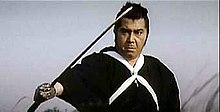Japanese actor
Tomisaburō Wakayama |
|---|
 Wakayama appearing as Ogami Ittō in
the Lone Wolf and Cub movie series |
| Born | Masaru Okumura
(1929-09-01)September 1, 1929
|
|---|
| Died | April 2, 1992(1992-04-02) (aged 62)
|
|---|
| Occupation | Actor |
|---|
| Years active | 1955–1991 |
|---|
| Spouse | Reiko Fujiwara (1963–1965)[citation needed] |
|---|
Tomisaburō Wakayama (若山 富三郎, Wakayama Tomisaburō, September 1, 1929 – April 2, 1992), born Masaru Okumura (奥村 勝),[1] was a Japanese actor best known for playing Ogami Ittō, the scowling, 19th-century ronin warrior in the six Lone Wolf and Cub samurai films.[1][2]
Biography
Wakayama (his stage name)[3] was born on September 1, 1929, in Fukagawa, a district in Tokyo, Japan.[1] His father was Minoru Okumura (奥村 実), a noted kabuki performer and nagauta singer who went by the stage name Katsutōji Kineya (杵屋 勝東治),[4][1] and the family as a whole were kabuki performers. He and his younger brother, Shintaro Katsu, followed their father in the theater.[1] Wakayama tired of this; at the age of 13, he began to study judo, eventually achieving the rank of 4th dan black belt in the art.[1]
In 1952, as part of the Azuma Kabuki troupe, Wakayama toured the United States of America for nine months.[2] He gave up theater performance completely after his two-year term with the troupe was over.[1] Wakayama taught judo until Toho recruited him as a new martial arts star in their jidaigeki movies,[1] originally using the stage name "Jō Kenzaburō". He prepared for these movies by practicing other disciplines, including kenpō, iaidō, kendo, and bōjutsu.[1] All this helped him for roles (now using the stage name "Wayakama Tomisaburō") in the television series The Mute Samurai,[4] the 1975 television series Shokin Kasegi (The Bounty Hunter),[4] and his most famous film role: Ogami Ittō, the Lone Wolf.
Wakayama went on to star in many films, performing in a variety of roles. It has been estimated that he appeared in between 250 and 500 films.[4] His only roles in American movies were as a baseball coach in The Bad News Bears Go to Japan (1978) and as a yakuza boss, Sugai, in Ridley Scott's Black Rain (1989) that delivers a memorable English monologue that becomes a defining moment for the film, and the film's title.[4][5]
Wakayama died of acute heart failure on April 2, 1992, in a hospital in Kyoto.[1][4] He was survived by a son, Kiichirō Wakayama (若山 騎一郎) born in 1964, also an actor.[6]
